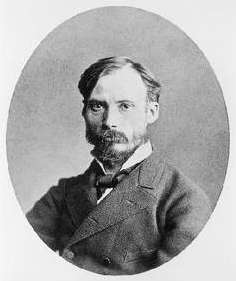Suzanne Valadon
| Suzanne Valadon | |
|---|---|
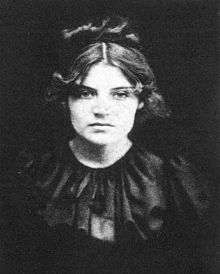 Valadon as a young woman | |
| Born |
Marie-Clémentine Valadon 23 September 1865 Bessines-sur-Gartempe, France |
| Died |
7 April 1938 (aged 72) Paris, France |
| Nationality | French |
| Known for | Painter and artist's model |
| Movement | Postimpressionism, Symbolism |
Suzanne Valadon (23 September 1865 – 7 April 1938) was a French painter and artists' model who was born Marie-Clémentine Valadon at Bessines-sur-Gartempe, Haute-Vienne, France. In 1894, Valadon became the first woman painter admitted to the Société Nationale des Beaux-Arts. She was also the mother of painter Maurice Utrillo. The subjects of her drawings and paintings included mostly female nudes, female portraits, still lifes, and landscapes. She never attended the academy and was never confined within a tradition.[1] Valadon spent nearly 40 years of her life as an artist.[2]
Personal life
Valadon grew up in poverty with her mother, an unmarried laundress; she did not know her father. Known to be quite independent and rebellious, she attended primary school until age 11. In 1883, aged 18, Valadon gave birth to her illegitimate son, Maurice Utrillo.[2] Valadon’s mother cared for Maurice while she returned to modelling.[3] Valadon's friend Miguel Utrillo would later sign papers recognizing Maurice as his son, although his true paternity is uncertain.[4] Valadon helped to educate herself in art by reading Toulouse-Lautrec’s books and observing the artists at work for whom she posed.[1]
In 1893, Valadon began a short-lived affair with composer Erik Satie, moving to a room next to his on the Rue Cortot. Satie became obsessed with her, calling her his Biqui, writing impassioned notes about "her whole being, lovely eyes, gentle hands, and tiny feet", but after six months she left, leaving him devastated.[5] Valadon married the stockbroker Paul Mousis in 1895, leading a bourgeois life for 13 years at an apartment in Paris and a house in the outlying region.[6] In 1909, Valadon began an affair with the painter André Utter, the 23-year-old friend of her son, divorcing Moussis in 1913.[7] Valadon married Utter in 1914,[8] and he managed her career as well as her son's.[9] Valadon and Utter regularly exhibited work together until the couple divorced in 1934.[9]
Valadon was well-known during her lifetime but within the art historical narrative her work has long been overshadowed by a Bohemian and lower class lifestyle.[10]
Career
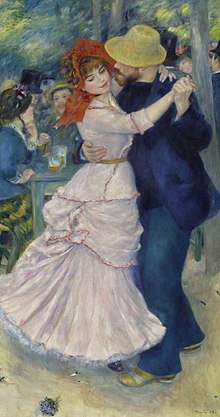
Valadon began working at age 11 in a variety of areas including a milliner’s workshop, a factory making funeral wreaths, a market selling vegetables, a waitress, and then finally in the circus.[11] At the age of 15 Valadon met, Count Antoine de la Rochefoucauld and Thèo Wagner, two symbolist painters who were involved in decorating circus belonging to Medrano. Through this connection she began work at the Mollier circus as an acrobat, but a year later, a fall from a trapeze ended that career. The circus was frequented by artists such as Lautrec, Sescau and Berthe Morisot and it is believed this is where Morisot did her painting of Valadon.[12]
In the Montmartre quarter of Paris, she pursued her interest in art, first working as a model for artists, observing and learning their techniques, before becoming a noted painter herself.[13] She began painting full-time in 1896.[8]
Model
Valadon debuted as a model in 1880 in Montmartre at age 15.[14] She modeled for over 10 years for many different artists including Pierre-Cécile Puvis de Chavannes, Théophile Steinlen Pierre-Auguste Renoir, Jean-Jacques Henner, and Henri de Toulouse-Lautrec.[2] She modeled under the name "Maria", eventually being nicknamed "Suzanne" by Toulouse-Lautrec, also her lover, after the biblical story of Susanna and the Elders as he felt that she especially liked modelling for older artists.[15][16] She was considered a very focused, ambitious, rebellious, determined, self-confident, and passionate woman.[3] In the early 1890s, she befriended Edgar Degas who, impressed with her bold line drawings and fine paintings, purchased her work and encouraged her; she remained one of his closest friends until his death. Art historian Heather Dawkins believed that Valadon's experience as a model added depth to her own images of nude women, which tended to be less idealized than that of the male post impressionists representations.[17]
The most recognizable image of Valadon would be in Renoir's Dance at Bougival from 1883, the same year that she posed for Dance in the City.[18] In 1885, Renoir painted her portrait again as Girl Braiding Her Hair. Another of his portraits of her in 1885, Suzanne Valadon, is of her head and shoulders in profile. Valadon frequented the bars and taverns of Paris with her fellow painters, and she was Toulouse-Lautrec's subject in his oil painting The Hangover.[19]
Artist
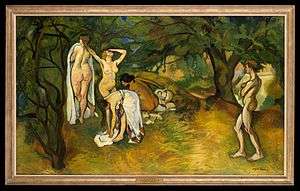
It is commonly believed that Valadon taught herself how to draw at the age of nine.[8] Valadon painted still lifes, portraits, flowers, and landscapes that are noted for their strong composition and vibrant colors. She was, however, best known for her candid female nudes that depict women's bodies from a woman's perspective.[20] This is particularly important because it was unusual in the nineteenth century for a woman artist to make female nudes her primary subject matter.[21] Valadon was not confined to a specific style, yet both Symbolist and Post-Impressionist aesthetics are clearly seen within her work.[22]
Accomplishments
Valadon's earliest surviving signed and dated work is a self-portrait from 1883, drawn in charcoal and pastel.[8] She produced mostly drawings between 1883 and 1893, and began painting in 1892. Her first models were family members, especially her son, mother, and niece.[23] Her earliest known female nude was executed in 1892.[24] In 1895, the art dealer Paul Durand-Ruel exhibited a group of twelve etchings by Valadon that show women in various stages of their toilettes.[8] Later, she regularly showed at Galerie Bernheim-Jeune in Paris.[25] Valadon’s first time in the Salon de la Nationale was in 1894. She also exhibited in the Salon d'Automne from 1909, Salon des Independants from 1911; Salon des Femmes Artistes Modernes, 1933-8.[26] Degas was notably the first person to buy drawings from her,[27] and he also introduced her to other collectors, including Paul Durand-Ruel and Ambroise Vollard. Degas also taught her the skill of soft-ground etching.[28]

In 1896, Valadon became a full-time painter after her marriage to the well-to-do banker Paul Mousis.[8] She made a shift from drawing to painting starting in 1909.[29] Her first large oils for the Salon related to sexual pleasure, and they were some of the first examples in painting for the man to be an object of desire by a woman. These notable Salon paintings include Adam and Eve (Adam et Eve) (1909), Joy of Life (La Joie de vivre) (1911), and Casting the Net (Lancement du filet) (1914).[30] Valadon produced around 300 drawings and over 450 oil paintings by the end of her life.[29]
Her works are in the collection of the Centre Georges Pompidou in Paris, the Museum of Grenoble, and the Metropolitan Museum of Art in New York, among others.
Style
Valadon primarily worked with oil paint, oil pencils, pastels, and red chalk; she did not use ink or watercolor because these media were too fluid for her preference.[6] Valadon’s paintings feature rich colors and bold, open brushwork often featuring firm black lines to define and outline her figures.[2] She used hard black lines to emphasize the structure of the body. She also used firm lines in her nudes to emphasize the play of light on curves.[4]
Valadon’s self-portraits, portraits, nudes, landscapes, and still lifes remain detached from trends and aspects of academic art.[31] The subjects of Valadon’s paintings often reinvent the old masters' themes: women bathing, reclining nudes, and interior scenes. However the nudes Valadon paints veer far from the norms of this male-dominated genre; the paintings are interpreted in a much different way which could contradict or question the nature of the genre.[10] Many have suggested a vibrant, emotional sense that emanates from her drawings and paintings as a result from an intimate, familiar observation of these women’s bodies. Similarly to Valadon, Berthe Morisot and Mary Cassatt painted mostly women, yet because of their middle class status in French society at the time they were unable to paint the nude body, regardless of gender.[10] However, in a divergence from her female contemporaries, Valadon also painted many nude self-portraits, across the span of her career. The later portraits are unflinchingly honest and unselfconsciously show the artist's aging body. Valadon also emphasized her focus on the importance of composition of her portraits over painting expressive eyes.[6] Her later works, such as Blue Room (1923), are brighter in color and show a new emphasis on decorative backgrounds and patterned materials.[32]
It is thought that her experience as a model and as an artist allowed her to analyze the process that transformed and positioned the body as an object of the gaze within a work of art and influenced her understanding and perspective of women and the female body.[33] Valadon has been considered transgressive in her position as a woman painting the nude female body.[34] Her class allowed her to enter the male public domain of art through modeling and then emerge as an artist within her circle of prominent male artists, and her lack of formal academic training may have made her feel more comfortable breaking with convention.[35] She resists typical depictions of women via their class and supposed sexuality through her use of unidealized and self-possessed bodies that are not overly sexualized.[36]
Feminist legacy
As one of the best documented French artists of the early 20th century, Valadon's body of work has been of great interest to feminist art historians, especially given her focus on the female form. Her work was candid and occasionally awkward, often characterized by strong lines, and her resistance to both academic and avant-garde conventions for representing the female nude have encouraged interest in her work:
"It has been argued that many of her images of women signal a form of resistance to some of the dominant representations of female sexuality in early 20th-century Western art. Many of her nudes painted from the 1910s onwards are heavily proportioned and sometimes awkwardly posed. They are conspicuously at odds with the svelte, 'feminine' type to be found in the imagery of both popular and 'high' art."[35]
Unlike her contemporary Mary Cassatt, Valadon did not identify as a feminist. Even so, her work has been reassessed and viewed in a feminist light, especially as it was created during a time period in which "The Woman Question" was gaining more interest and prominence.
Group exhibitions
- 1894, Société Nationale des Beaux-Arts, Paris; 1907, Galerie Eugène Blot, Paris;
- 1909, 1910, 1911, Salon d'Automne, Grand Palais, Paris;
- from 1911, 1926 (retrospective), Salon des Indépendants, Paris;
- 1917, Utrillo, Valadon, Utter, Galerie Berthe Weill, Paris;
- 1920, Second Exhibition of Young French Painting, Galerie Manzy Joyant, Paris;
- 1921, Young Painting, Palais d'Ixelles;
- 1927 and 1928, Salon des Tuileries, Paris;
- from 1933-1938 and regularly, Salon des Femmes Artistes Modernes, Paris.
- After her death: 1940, 22nd Biennale Internationale des Beaux-Arts, Paris;
- 1949, Great Trends in Contemporary Painting from Manet to our Day, Musée des Beaux-Arts, Lyons; 1961, Maurice Utrillo V. Suzanne Valadon, Haus der Kunst, Munich;
- 1964, Documenta, Kassel;
- 1969, 14th Salon de Montrouge;
- 1976, Women Artists (1550-1950), Los Angeles County Museum of Art;
- 1979, Maurice Utrillo, Suzanne Valadon, Musée Toulouse-Lautrec,
- Albi; 1991, Utrillo, Valadon, Utter, Chateau Constant, Bessines
- 1991, Utrillo, Valadon, Utter: la Trilogie Maudite, Acropolis, Nice.
Solo exhibitions
- 1911, the first, at the Galerie Clovis Sagot;
- 1915, 1919, 1927 (retrospective) and 1928, Galerie Berthe Weill, Paris;
- 1922, 1923 and 1929, Galerie Bernheim-Jeune, Paris;
- 1928, Galerie des Archers, Lyons;
- 1929 and 1937, Galerie Bernier, Paris;
- 1931 and 1932, Galerie Le Portique, Paris;
- 1931, Galerie Le Centaure, Brussels;
- 1932, retrospective with a preface by Édouard Herriot, Galerie Georges Petit, Paris.
- 1938, 1942, 1947, 1959 and 1962, Galerie Pétridès, Paris;
- 1939 and 1947, Galerie Bernier, Paris;
- 1948, Tribute to Suzanne Valadon, Musée National d'Art Moderne, Paris;
- 1956, The Lefevre Gallery, London;
- 1967, Musée National d'Art Moderne, Paris;
- 1996, Suzanne Valadon, Pierre Gianada Foundation, Martigny.
Permanent collections
- Albi: Still-life with Stemmed Glass
- Algiers: Rue Cortot
- Belgrade: Still-life, Flowers and Striped Cloth
- Bern (Kunstmus.): Duck Eggs (1931, on loan from the Fondation Im Obersteg)
- Besançon (MBA et d'Archéologie): Duck (1930)
- Cambrai (MBA): Portrait of Madame Lévy (1922, on loan from the Musée national d'Art moderne in Paris)
- Cologne (Wallraf-Richartz Mus.): Portrait of a Woman (1925-1928)
- Geneva (Petit Palais): After the Bath (1908, pastel); The Future Revealed, or the Fortune Teller (1912); Woman with Double Bass (c. 1914-1915); Standing Nude with Long Hair (1916, pencil); Nude Lying on a Red Sofa (1920); Nude with Drapery (1920)
- Limoges (Mus. Municipal de L'Évêché): Nude Girl and Servant (1896, red chalk); Couturier (1914); Bouquet of Flowers with Embroidered Mat (1930, on loan from the Musée national d'Art moderne in Paris)
- Lyons: Berthe and her Daughter with Doll
- Lyons (MBA): Toilette (1908, pencil and pastel); Marie Coca and her Daughter Gilberte (1914)
- Minneapolis Institute of Art: Women, c.1895 (1932 edition) lithograph
- Monte Carlo: Portrait of Mauricia Gustave-Coquiot
- Nancy (MBA): Woman with White Stockings (1924)
- New York (Metropolitan Mus. of Art): After the Bath (1893, pencil); Nude Young Girl Sitting at her Toilette (c. 1895, pencil); Joie de Vivre (1911); Reclining Nude (1928)
- New York (MoMA): Children's Bath in the Garden (1910, drawing)
- Paris (MAMVP): Mother and Child (c. 1900, wax crayon); Maurice Utrillo at his Easel (1919, oil on canvas); Nude beside the Bed (1922, oil on canvas); Violin Case (1923); Still-life with Drapery and Bunch of Carnations (1924)
- Paris (MNAM-CCI): Portrait of the Artist (1883, pastel); The Grandmother (1883, red chalk); Maurice Utrillo as a Child (1896, red chalk); Young Girl Crocheting (c. 1892); Maurice Utrillo Naked, Sitting on a Divan (1895, pencil); Two Nudes: Woman Sitting, Woman Lying down (1897, charcoal); Portrait of the Artist (1903, red chalk); Nude Girl Sitting on the Ground, her Legs Stretched out (1894, charcoal and gouache); Self-portrait (1903, red chalk); Female Nude Sitting on a Towel (1908, charcoal and pastel); Female Nude Getting out of the Bath near an Armchair (c. 1908, charcoal and red chalk); Nude Model Standing and Woman Cleaning a Bath (c. 1908, charcoal); André Utter, Nude, from the Front (c. 1909, charcoal); Adam and Eve (1909); Neither Black nor White, or After the Bath (1909); Maurice Utrillo, his Grandmother and his Dog (1910); Portrait of Maurice Utrillo, his Head Resting on his Fist, or Utrillo Thinking (1911, charcoal on tracing paper); Still-life with Teapot (1911, charcoal); André Utter, Standing Nude (1911, charcoal, study for 'La joie de vivre'); Portrait of the Artist's Mother (1912); Two Studies of Nudes, or Nudes in the Mirror (1914, charcoal and pastel); Couturier (1914); Casters of Nets or Casting the Net (1914); Flowers (1920); Portrait of the Utter Family (c. 1921); Woman at her Chest of Drawers (1922); Portrait of Miss Lily Walton (1922); Portrait of Madame Nora Kars (1922); House in a Garden (Château de Sogalas, Basses-Pyrénées) (1923); Blue Room (1923); Female Nude Standing Holding a Palette (1927, charcoal, study for a poster); Village of Saint-Bernard, Ain (1929)
- Paris (Mus. de Montmartre): Self-portrait (1894, pencil and pen)
- Paris (Mus. du Petit Palais): Nude with Striped Blanket (1922); Violin
- Pittsburgh (Carnegie MA): Tree at Montmagny Quarry (c. 1910, oil on canvas); Woman Combing Her Hair (1905, crayon)
- Prague: Flowers
- San Francisco (FAM): Toilette de deux enfant dans le jardin (1910); Toilette de Petit garcon (1908); Femme en buste, les mains jointes
- Sannois (Musée Utrillo-Valadon): Family Portrait (1913, pencil)
- Washington DC (National Mus. of Women In the Arts): Nude Doing his Hair (c. 1916); Abandoned Doll (1921); Bathing the Children in the Garden (1910, etching and dry-point on paper); Bouquet of Flowers in an Empire Vase (1920, oil on canvas); Girl on a Small Wall (1930, oil on canvas)[8]
Death
Suzanne Valadon died of a stroke[37] on April 7, 1938, at age 72, and was buried in the Cimetière de Saint-Ouen in Paris. Among those in attendance at her funeral were her friends and colleagues André Derain, Pablo Picasso, and Georges Braque.
Novels and plays
A novel based on her life by Elaine Todd Koren was published in 2001, entitled Suzanne: of Love and Art.[38] An earlier novel by Sarah Baylis, entitled Utrillo's Mother, was published first in England and later in the United States. Timberlake Wertenbaker's play, The Line (2009), traces the relationship between Valadon and Degas. Valadon was the basis for the character Suzanne Rouvier in the novel The Razor's Edge by W. Somerset Maugham.[39]
Honors
Both an asteroid (6937 Valadon) and a crater on Venus are named in her honor.
The small square at the base of the Montmartre funicular in Paris is named Place Suzanne Valadon. At the top of the funicular, and less than 50 meters to its east, are the steps named rue Maurice Utrillo after her son the artist.
Gallery
Artwork by Valadon

 Self-Portrait, 1883, by Suzanne Valadon
Self-Portrait, 1883, by Suzanne Valadon My Son at 7 Years Old, by Suzanne Valadon
My Son at 7 Years Old, by Suzanne Valadon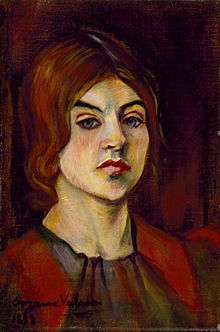 Self-Portrait, 1893, by Suzanne Valadon
Self-Portrait, 1893, by Suzanne Valadon Nude, 1895, by Suzanne Valadon
Nude, 1895, by Suzanne Valadon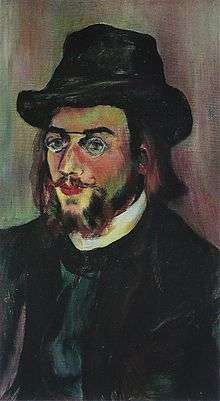 Portrait of Erik Satie, 1893, by Suzanne Valadon
Portrait of Erik Satie, 1893, by Suzanne Valadon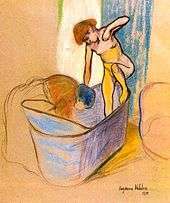 The Bath, 1908, by Suzanne Valadon
The Bath, 1908, by Suzanne Valadon Nudes, 1919, by Suzanne Valadon
Nudes, 1919, by Suzanne Valadon Flowers on a Round Table, 1920, by Suzanne Valadon
Flowers on a Round Table, 1920, by Suzanne Valadon Portrait of Maurice Utrillo, by Suzanne Valadon
Portrait of Maurice Utrillo, by Suzanne Valadon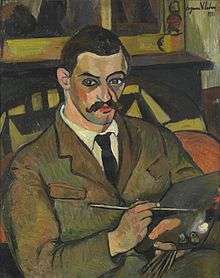 Portrait of the Painter Maurice Utrillo, 1921, by Suzanne Valadon
Portrait of the Painter Maurice Utrillo, 1921, by Suzanne Valadon Still Life with Tulips and Fruit Bowl, 1924, by Suzanne Valadon
Still Life with Tulips and Fruit Bowl, 1924, by Suzanne Valadon Bouquet of Flowers, 1928, by Suzanne Valadon
Bouquet of Flowers, 1928, by Suzanne Valadon Still Life with Basket of Apples Vase of Flowers, 1928, by Suzanne Valadon
Still Life with Basket of Apples Vase of Flowers, 1928, by Suzanne Valadon- Young Girl in Front of a Window, 1930, by Suzanne Valadon
Portraits of Valadon
 The Hangover (Suzanne Valadon), by Toulouse-Lautrec.
The Hangover (Suzanne Valadon), by Toulouse-Lautrec. Profile portrait of Suzanne Valadon, by Renoir.
Profile portrait of Suzanne Valadon, by Renoir._-_Google_Art_Project.jpg)
Illustrations
- Jean Cocteau, Bertrand Guégan (1892-1943); L'almanach de Cocagne pour l'an 1920-1922, Dédié aux vrais Gourmands Et aux Francs Buveurs[40]
See also
- Musée de Montmartre, established in the building in which Valadon had an apartment and studio.
Notes
- 1 2 Warnod 40
- 1 2 3 4 Marchesseau 9
- 1 2 Marchesseau 15
- 1 2 Warnod 48
- ↑ "Suzanne Valadon". Akademiska Föreningen, Lund University. Archived from the original on 3 October 2010. Retrieved 12 June 2010.
- 1 2 3 Marchesseau 16
- ↑ Marchesseau 17-18
- 1 2 3 4 5 6 7 Giraudon, Oxford Art Online
- 1 2 Jimenez, Jill Berk (2001). Dictionary of Artist's Models. London: Routledge. p. 529.
- 1 2 3 Mathews, Patricia (1991). "Returning the Gaze: Diverse Representations of the Nude in the Art of Suzanne Valadon". The Art Bulletin. 73.
- ↑ Warnod 13
- ↑ Warnod, Jeanine (1981). Suzanne Valadon. New York: Crown Publishers, INC. p. 13.
- ↑ "Suzanne Valadon". National Museum of Women in the Arts. Retrieved December 20, 2012.
- ↑ Rose 9
- ↑ Marchesseau 14
- ↑ Drees, Della. "Valadon and her studio in Montmartre". Retrieved 20 August 2018.
- ↑ Iskin, Ruth (2004). "The Nude in French Art and Culture". CAA Reviews.
- ↑ Smee, Sebastian. "At MFA, dancing the night away in the arms of Renoir". The Boston Globe. Retrieved April 10, 2013.
- ↑ "Henri de Toulouse-Lautrec". Harvard Art Museums. Retrieved December 20, 2012.
- ↑ Burns, Janet M.C. Looking as Women: The Painting of Suzanne Valadon, Paula Modersohn-Becker and Frida Kahlo, Atlantis 1993: 18(1&2): 25-46.
- ↑ Betterton, Rosemary (Spring 1985). "How Do Women Look? The Female Nude in the Work of Suzanne Valadon". Feminist Review. 19: 3–24 [4]. doi:10.1057/fr.1985.2.
- ↑ Dolan, Threse (2001). "Passionate Discontent: Creativity, Gender and French Symbolist Art". CAA Reviews.
- ↑ Warnod 48, 57
- ↑ Rose 97
- ↑ "Suzanne Valadon". Brooklyn Museum of Art. Retrieved December 20, 2012.
- ↑ Gaze, Delia (1997). Dictionary of Women Artists Volume 2 Artists, J-Z. Library of the Minneapolis Institute of Art: Fitzroy Dearborn Publishers. p. 1384. ISBN 1-884964-21-4.
- ↑ Warnod 51
- ↑ Warnod 55
- 1 2 Marchesseau 17
- ↑ Marchesseau 18-19
- ↑ Marchesseau 9, 11
- ↑ "Suzanne Valadon". Museum of Modern Art. Retrieved March 7, 2013.
- ↑ Mathews 415
- ↑ Mathews 418
- 1 2 Gaze, Delia (1997). Dictionary of Women Artists, Volume 2 (Artists, J-Z). Chicago: Fitzroy Dearborn Publishers. OCLC 873790995.
- ↑ Mathews 416, 419, 423
- ↑ Warnod 88
- ↑ Koren, Elaine Todd (2001). Suzanne: of Love and Art. Maverick Books.
- ↑ The Razor's Edge by W. S. Maugham
- ↑ Notice WorldCat; sudoc; BnF. Engraved on wood and unpublished drawings of: Matisse, J. Marchand, R. Dufy, Sonia Lewitska, de Segonzac, Jean Émile Laboureur, Friesz, Marquet, Pierre Laprade, Signac, Louis Latapie, Suzanne Valadon, Henriette Tirman and others.´
References
- Burns, Janet M.C. (1993). "Looking as Women: The Paintings of Suzanne Valadon, Paula Modersohn-Becker and Frida Kahlo". Atlantis. 18 (1&2): 25–46.
- Birnbaum, Paula J. Women Artists in Interwar France: Framing Femininities. Aldershot: Ashgate, 2011. Print.
- Giraudon, Colette. "Valadon, Suzanne." Grove Art Online. Oxford Art Online. Oxford University Press. Web. 24 Sep. 2014. Online http://www.oxfordartonline.com/subscriber/article/grove/art/T087579
- Marchesseau, Daniel. Suzanne Valadon, exhibition catalogue, Martigny, Fondation Pierre Gianadda, 1996
- Mathews, Patricia (1991). "Returning the Gaze: Diverse Representations of the Nude in the Art of Suzanne Valadon". Art Bulletin. 73 (3): 415–30. doi:10.2307/3045814.
- Rose, June. Suzanne Valadon: The Mistress of Montmartre. New York: St. Martin's, 1999. ISBN 0-312-19921-X
- Storm, John. The Valadon Drama. New York: E.P. Dutton, 1958. Online https://archive.org/details/valadondramathel027482mbp
- Warnod, Jeanine. Suzanne Valadon. New York: Crown, 1981. Print.
External links
| Wikimedia Commons has media related to Suzanne Valadon. |
